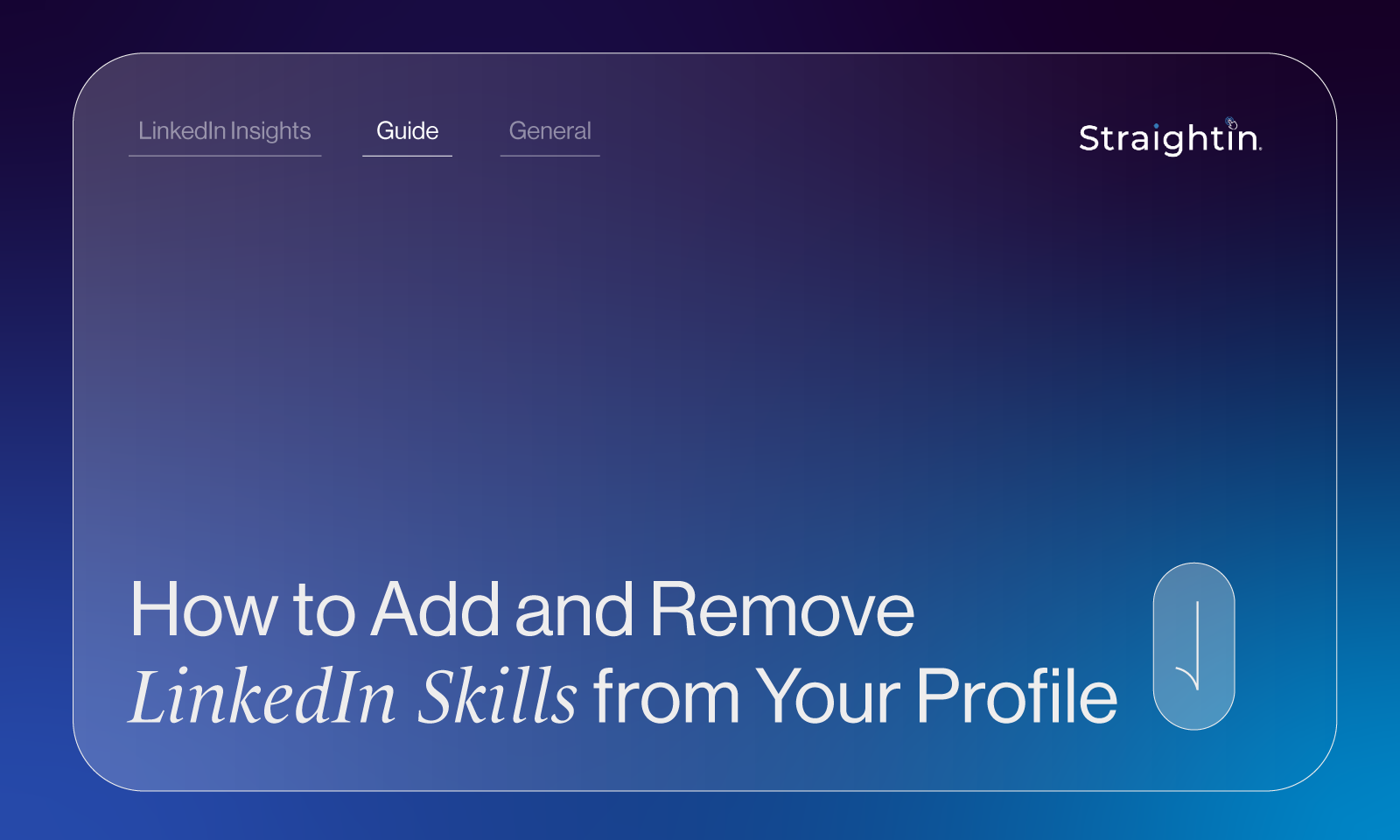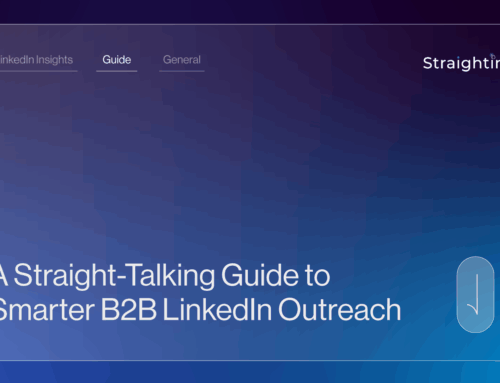That’s why it’s important that your profile has a headline indicating your field and career experience, as well as ensuring your career history is updated. What’s more, you can also add skills to your LinkedIn profile to further add credibility to your experience.
If you’re interested in optimising your profile, but don’t know where to start, we’ve got all the details you need below. Read on to find out how to add skills to your LinkedIn profile, why it’s important to do so, and what skills you should avoid adding.
Want to know more about the advantages of implementing a B2B marketing strategy on LinkedIn? Get in touch with the leading LinkedIn Manchester agency, StraightIn today to learn more.
So…how do you add skills on LinkedIn?
To add skills on LinkedIn, take the following steps:
View profile
Firstly, click the Me icon. This is located at the top of your LinkedIn homepage, and looks like this:
![]()
A dropdown will appear and you’ll need to select View Profile.

Scroll to the skills section
Next, you need to click scroll to the skills section, which looks something like this:

To add a skill, click the plus button.
Add desired skills
A pop up will appear, allowing you to type the name of a skill and select it from the dropdown list that appears (only recognised ones will appear). Alternatively, you can select a skill from Suggestions based on your profile. After you’ve selected it, you’re done! Just ensure you save your changes.
How do you remove skills on LinkedIn?
To remove skills on LinkedIn, follow the same process as above. Once you get to the skills section, instead of clicking the plus sign, click the pen icon.

Here, the list of skills that you have previously added to the platform will be displayed. Click the pen icon next to the one you want to change and then select delete skill. Once you’ve done that, press save to update your changes.
![]()
Why is it important to add skills on LinkedIn?
Adding skills to your LinkedIn profile only takes a small amount of time, but can have a big impact. Doing so helps you to:
Add credibility to your profile
One reason why it’s important to add skills to your LinkedIn profile is that it adds credibility to your career experience. For example, if you have existing or previous colleagues endorse your skills, it further supports your ability to perform in a specific role. This provides tangible proof to businesses that you’re capable of conducting certain tasks.
Show recruiters your eligibility
Adding skills to your LinkedIn profile also shows recruiters your eligibility for certain roles. For example, if a position a recruiter is advertising is industry-specific and requires certain knowledge, seeing it listed on your profile will allow them to see that you’re suitable for the role and increase the chances of them inviting you to apply/interview.
Connect with likeminded people
Listing skills on your LinkedIn profile also encourages you to connect with likeminded people. If you do so, LinkedIn will automatically suggest connections to you that share the same skills. Subsequently, you’ll be able to expand your LinkedIn network with people in similar roles and industries to yourself. This can be particularly beneficial when it comes to your own career development.
What types of skills should I add to my LinkedIn profile?
Adding skills to your LinkedIn profile only makes a meaningful impact when they’re actually relevant to what you do/your industry. Let’s take a look at the ones you should prioritise adding below:
Industry-specific skills
The most important skills you should add to your LinkedIn profile are industry-specific skills. As the name suggests, these are skills that are especially useful in certain sectors and positions. Highlighting them on your profile can be valuable as it can show recruiters for these roles that you understand the demands and technicalities of the position – further displaying your eligibility for a role.
Transferable skills
Adding transferable skills can also be beneficial to those looking to make the most of their LinkedIn profile. Transferable skills are any qualities you might have gained that might not be specific to a role or industry, but can still be seen as valuable. For example, this might include interpersonal and communication skills – which demonstrates your ability to connect with others and build a rapport.
Soft skills
Similar to transferable skills, soft skills are qualities that might make you eligible for certain roles. For example, if you’re a naturally warm and outgoing person, working in a client-facing role might be the most suitable as you won’t find it too difficult to build a professional relationship with them.
What are skills I should avoid adding?
Now we know what skills you should add to your LinkedIn profile, let’s take a look at the ones you should avoid adding:
Outdated technology skills
Being able to work with outdated technology will have no impact on your ability to perform in a modern working environment. So avoid adding your understanding of this to your LinkedIn. Otherwise, it can make you seem out-of-touch and unable to work with more sophisticated forms of technology.
Basic technical skills
Decades ago, the ability to touch type would have been a desirable skill that didn’t pertain to many. Nowadays, with children growing up with smartphones and laptops at their fingertips – touch typing is expected rather than desired. So ensure you avoid listing these skills on your profile, and instead opt for ones that are more in keeping with modern technology and equipment – such as proficiency in Microsoft Excel.
Outdated communication methods
Another set of skills you should avoid adding to your LinkedIn profile are outdated methods of communication. A few decades ago, the ability to send a fax might have been desirable – but with updated technology and phones, there’s no expectation from businesses for this now. Avoid adding this type of skill to your LinkedIn profile as it might make recruiters or business leaders believe you aren’t up to date with the latest industry standards.
Showcase your skills on LinkedIn and make meaningful connections with guidance from StraightIn
When it comes to B2B marketing, it’s important to ensure you’re utilising the best professional platforms – such as LinkedIn. But when running a business, it can be hard to find time for this amongst your everyday operations.
That’s why so many B2B businesses turn to the experts at StraightIn for help. When you work alongside us, we make your business our priority. We listen to your goals and ensure we understand the issues you face – so we can create a LinkedIn marketing strategy to align with this. Whatever metrics you want to see an improvement in, be it lead generation or conversions – we can help you get there.
Our services include Outreach Marketing, LinkedIn Advertising, Content Marketing, and Personal Branding. Contact us today to find out more about how we can help you. Call 0161 518 4740 or email grow@straight-in.co.uk.
Adding skills on LinkedIn: FAQs
How many skills should I add to my LinkedIn profile?
You can add up to 50 skills to your LinkedIn profile, but ensure you’re only adding ones that are associated with your industry and demonstrate your experience. Otherwise, you’ll end up adding skills that aren’t relevant to your sector and might fail to see relevant job listings.
Should I add both hard and soft skills to my profile on LinkedIn?
Yes, you should add both hard and soft skills to your LinkedIn profile. This helps to show you’re a well-rounded individual who possesses both technical abilities and interpersonal skills – both of which are a requirement in many jobs.








